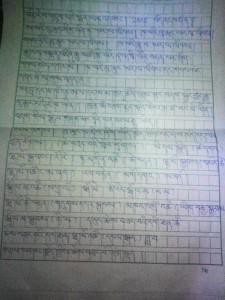Jigjey Kyab, 17, was found dead on 19 Jan, with his body doused with kerosene and lighters in his hand in the a busy street in the Shigtsang Pungkor region of Luchu, eastern Tibet. He apparently died before he could set himself on fire, having consumed poison prior to his self-immolation protest to ensure that he didn’t fall into the hands of the Chinese authorities alive. In a last note left by his bedside, which was later found by his family members, Jigjey Kyab has called on Tibetans to rise up. “I pray that my aspirations will be fulfilled. If you are your mother’s son – rise up. Sons of the Land of Snows – rise up. Singers of the Snow Land – rise up. May His Holiness the Dalai Lama live for thousands of aeons. My respect to the white snow lion (symbol of Tibet). My prayers for happiness in Tibet.”
He further made an emotion appeal to his parents in his handwritten note written in Tibetan, dated January 19, the day of his self-immolation attempt: “Father and mother, it is my hope that you will take care of yourselves. You are the most loving people in this world. I will repay your kindness in my next life.” Jigjey Kyab was cremated three days later on January 22, after perceived pressure and warnings from the Chinese authorities. He is survived by his father Dhugkar Kyab, mother Dekyi Tso and sister Choekyong Tso who remember him as “an obedient and well-mannered boy, who was patriotic and felt strongly for the Tibetan self-immolators.”




 Print
Print Email
Email













